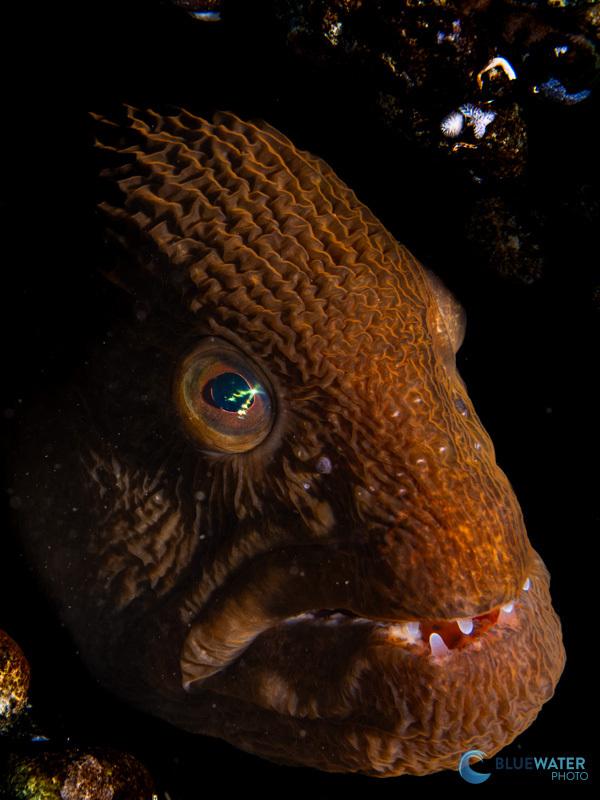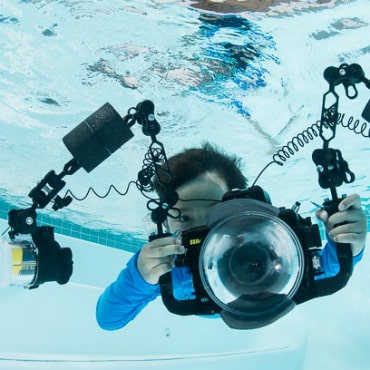Marelux Apollo S Underwater Strobe Review
Posted by Nirupam Nigam on February 4th, 2025

The Marelux Apollo S is Marelux's latest underwater strobe in the Apollo lineup. As a mid-range little brother to the high-end Marelux Apollo III, the Apollo S can output an impressive amount of power, reaching a guide number of 36! Additionally, the Apollo S is equipped with multiple unique modes, including HSS, MTL, RC TTL, and TTL. These may sound like a bunch of silly acronyms, but as you read further, you'll find that they make the Apollo S unprecedentedly versatile. Moreover, the strobe exists as part of the Marelux "ecosystem". This gives you access to unique tools like wireless strobe triggering through the Marelux Lumilink 2.0 and compatibility with the Marelux SOFT Lite snoot. Fortunately, we've had the unique opportunity of diving with the Marelux Apollo S over multiple months all along the Pacific Coast of the United States. We've photographed everything from the show-stopping garibaldi of Southern California to the surprisingly ugly wolf eels of Tacoma, Washington. So let's take a deeper look at what makes the Apollo S, retailing for $849, the most versatile strobe in the mid-range strobe market...
Marelux Apollo S Specifications
- Maximum Guide Number 36 (on land)
- 0.9 second recycle time at full power
- Beam angle of 110 degrees (120 degrees with normal diffusers, and 140 degrees with dome diffusers)
- Support for TTL, RC, HSS, MTL, wireless triggering (The TTL, HSS, and RC modes require compatible flash triggers)
- Strobe has 2 fisheye wireless signal sensor units - sensor coverage is 160 °
- Full power flash: around 800 times
- Wireless trigger supports M, MTL, HSS. (TTL, RC needs fiber)
- Temp 6200k
- With dome diffuser, scattering angle 120-140 °, Temp 5500k
- Fiber optic trigger port
- Batteries: 2x 18650H batteries
- Max diameter 70mm, length of main body 140mm, full length including knobs 160mm
- Weight on land: 720 grams (without battery, with ball mount), 813 grams with 2x18650 batteries (with ball mount)
- Weight in water: 150 grams (including 2x18650 batteries, including ball mount). The weight after putting on the buoyancy suit is 50 grams
- Waterproof Depth : 100m
- US MSRP: $849
Support our content and purchase your Marelux Apollo S and Lumilink 2.0 Wireless Transmitter at Bluewater Photo:
Recommended Batteries: Three 18650H batteries at Bluewater Photo

Marelux Apollo S Key Features
A Bright Beam and Quick Recycle Time
The brightness benchmark for most "pro" grade underwater strobes is a guide number of about 30 or about 120-160 watt seconds of power. This is enough light to brighten your subject while it is backlit by the sun - an important composition for wide-angle photography. The Apollo S clocks in at a guide number of 36. This is accomplished by two stacked flash tubes. While it's not as bright as the Apollo III with a guide number of 44, the S has sufficient light output for most underwater photographers. Wide-angle photographers will be pleased with how they can light up subjects in bright, shallow environments. Macro shooters will have enough light for any shooting situation.
We do recommend using the diffusers available in the Bluewater exclusive package to soften the light a bit. Without the diffusers, I've noticed that the light can have harder edges than I would personally like.
Perhaps the most compelling aspect of the Apollo S's circuitry is the quick recycle time at full output. When the strobe dumps a full load of light, the recycle time is only 0.9 seconds! This is about 30% quicker than contemporaries. Essentially, you should be able to shoot at 10-30 frames per second and have consistent exposures between shots. But ultimately, this depends on your power. As you decrease the amount of light coming from the strobe with the power knob, you decrease the recycle time as well. So in the dark diving conditions of the Pacific Northwest, we were able to shoot incredibly fast bursts with the strobes.

This female wolf eel was moving around its den, requiring me to shoot at a quick burst speed. Thankfully the recycle time was lightning fast as I was shooting at a low power. Photographed with the Marelux Apollo S strobe, Marelux Nikon Z8 housing, Nikon 60mm macro lens, and Kraken KRL-09S Macro to Wide Lens. f/13, 1/25, ISO 1250
800 Shot Battery Life
As we mentioned in the specifications, the Apollo S takes just two 18650H lithium-ion batteries. This results in an incredible battery life of 800 shots. While we were able to shoot hundreds of photos on a pair of batteries, one of my few criticisms about the strobes was the lack of a "sleep mode." After I accidentally left the strobes on for a day, their batteries did die. But if I remembered to actually turn off my strobes between dives, I found that I can dive for 2-3 days (4-8 dives) on a single pair of batteries!

As our dives came to a close after a day of diving, this was the last photo I captured at Catalina. I still had ample battery life for more dives. We recommend charging the Apollo S strobes once a day, and you'll be ready for your next adventure!
Strobe Triggering Methods
Like many new strobes on the market, the Apollo S's only wire-based triggering system is fiber optic. There is no compatibility with wired sync cords. This means the strobe can only be triggered when an optical flash signal from a camera or flash trigger transmits light to the strobe's optical port. The Apollo S is equipped with a Sea & Sea style optical port on the side of the strobe. The placement of the port makes it so your cable never gets in the way. But the Apollo S has another important trick up its sleeve. the strobe can also be triggered wirelessly via encrypted blue light from the Marelux lumilink 2.0. The lumilink eliminates the need for fiber optic cables or sync cords. We used the lumilink extensively while diving with the Apollo S strobes in California. It felt freeing to move strobes around without cables interfering. But it's also important to remember that you need a direct line of sight from the lumilink to the strobe wireless fisheye port. This can make close focus wide-angle a bit tricky at times.

Who needs fiber optic cables anyway? This photograph was captured via wireless strobe triggering of the Apollo S strobes. I used a lumilink with a Sony A7 IV in a Marelux A7 IV housing with a Sony 16-35mm lens. f/14, 1/100, ISO 200
Versatile Shooting Modes Set the Apollo S Ahead of Competitors
It's really versatility and the sheer number of modes on the Apollo S that sets the strobe apart. Besides being manually controlled through a manual power dial, the strobe is capable of accepting TTL and RC TTL signals that allow it to "automatically" select the correct strobe power. Moreover, the Apollo S is compatible with high-speed synch shooting. High-speed sync allows you to use your strobe with your camera at shutter speeds higher than your camera's "sync" speed. It makes it easier to capture black backgrounds or to freeze action. Finally, the Apollo S has a new and unique mode called MTL (continuous flash mode). It allows you to capture multiple frozen positions of a subject with multiple flashes during a long exposure. It's an interesting option for creative photography!

Black backgrounds are easier to capture in HSS mode - a mode not usually found on mid-range strobes like the Apollo S. This wolf eel was captured with the Apollo S and Nikon Z8 in a Marelux housing. f/16, 1/160, ISO 400
Size, Construction, and Ergonomics
Like other Marelux strobes, the Apollo S is built from a solid block of anodized aluminum. Despite that, it's surprisingly lightweight. It weighs in at just 150 grams underwater and 813 grams on land. The strobes come with a neoprene cover that helps keep them buoyant underwater and protects the strobe as well. The strobe is quite compact overall and is a very similar size to the similarly priced Sea & Sea YS-D3 Duo.
My favorite aspect of the strobe's construction is the easy-to-read, glow-in-the-dark panel on the back of the strobe. The knobs are nice and big, which makes it easy to change power with gloves on while diving in cold water.
The one downside of the Apollo S is the lack of a modeling light. However, I don't typically use a modeling light on my strobes because I prefer using a Bluewater focus light to independently focus on subjects. If you point your strobe too directly at subjects, you increase the amount of backscatter in your photo.

A classic Southern California kelp forest scene photographed with the Marelux Apollo S strobe. f/14, ISO 200, 1/100
Who should buy the Marelux Apollo S Strobes?
The Marelux Apollo S strobes are designed for photographers that need the best value for money in an underwater strobe without compromising on performance and versatility. But perhaps most uniquely among underwater camera gear manufacturers, the Apollo S is for someone that wants to buy into the Marelux ecosystem. This includes wireless strobe control with the Lumilink 2.0 and snoot photography with the Marelux SOFT Lite. When used properly, this strobe is the creative photographer's dream.
Bluewater Photo's Sweet Deal!
We thought we would end this review with a little treat for you... For a limited time, Bluewater Photo is offering a sweet, exclusive deal on the Marelux Apollo S. With each strobe you buy, you can receive a FREE fiber optic cable, white 140 degree diffuser and yellow 140 degree diffuser. Just click here!

Beautiful soft lighting from the Marelux Apollo S lights up this difficult to photograph anemone.




